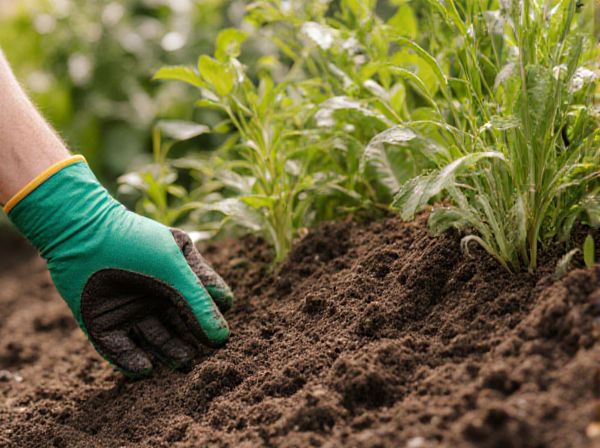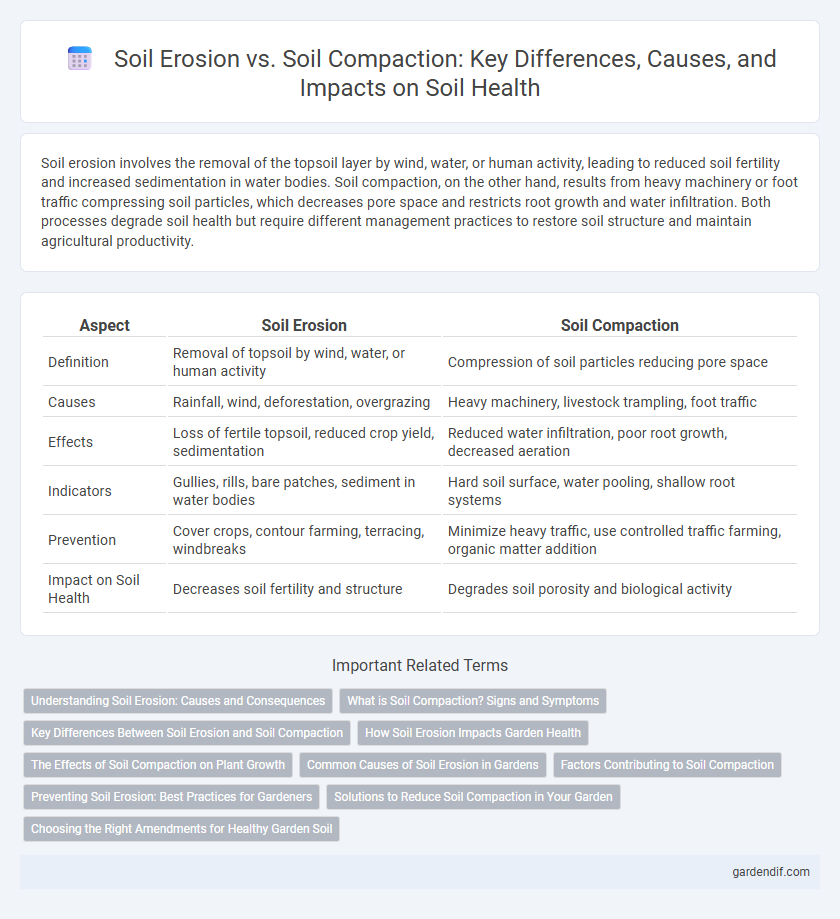
Soil Erosion vs Soil Compaction Illustration
Soil erosion involves the removal of the topsoil layer by wind, water, or human activity, leading to reduced soil fertility and increased sedimentation in water bodies. Soil compaction, on the other hand, results from heavy machinery or foot traffic compressing soil particles, which decreases pore space and restricts root growth and water infiltration. Both processes degrade soil health but require different management practices to restore soil structure and maintain agricultural productivity.
Table of Comparison
| Aspect | Soil Erosion | Soil Compaction |
|---|---|---|
| Definition | Removal of topsoil by wind, water, or human activity | Compression of soil particles reducing pore space |
| Causes | Rainfall, wind, deforestation, overgrazing | Heavy machinery, livestock trampling, foot traffic |
| Effects | Loss of fertile topsoil, reduced crop yield, sedimentation | Reduced water infiltration, poor root growth, decreased aeration |
| Indicators | Gullies, rills, bare patches, sediment in water bodies | Hard soil surface, water pooling, shallow root systems |
| Prevention | Cover crops, contour farming, terracing, windbreaks | Minimize heavy traffic, use controlled traffic farming, organic matter addition |
| Impact on Soil Health | Decreases soil fertility and structure | Degrades soil porosity and biological activity |
Understanding Soil Erosion: Causes and Consequences
Soil erosion occurs when wind or water removes the topsoil layer, leading to loss of nutrients and diminished agricultural productivity. Key causes include deforestation, overgrazing, and improper land use, which expose soil surfaces and reduce vegetation cover. Consequences involve decreased water retention, increased sedimentation in waterways, and heightened risk of desertification.
What is Soil Compaction? Signs and Symptoms
Soil compaction occurs when soil particles are pressed together, reducing pore space and limiting air, water, and nutrient movement essential for plant growth. Common signs include poor water infiltration, surface crusting, stunted root development, and increased runoff. Symptoms often manifest as wilting plants, reduced crop yields, and hardened soil layers that resist root penetration and microbial activity.
Key Differences Between Soil Erosion and Soil Compaction
Soil erosion involves the removal of topsoil by water, wind, or human activity, leading to nutrient loss and reduced soil fertility. Soil compaction occurs when soil particles are pressed together, decreasing pore space, reducing water infiltration, and hindering root growth. Key differences include the fact that erosion physically removes soil material, while compaction alters soil structure without soil loss.
How Soil Erosion Impacts Garden Health
Soil erosion removes the topsoil layer rich in organic matter and nutrients essential for plant growth, leading to reduced fertility and stunted garden plants. It also destabilizes soil structure, causing poor water retention and increased runoff, which deprives roots of adequate moisture. The loss of protective ground cover through erosion exposes roots to environmental stress, making gardens more susceptible to pests and diseases.
The Effects of Soil Compaction on Plant Growth
Soil compaction reduces pore space, limiting oxygen availability and water infiltration essential for root development. This restriction impedes root growth, lowers nutrient uptake, and diminishes plant vitality and yield. Compacted soil also increases runoff and erosion risk, further degrading soil structure and fertility.
Common Causes of Soil Erosion in Gardens
Common causes of soil erosion in gardens include heavy rainfall, which washes away topsoil, and improper watering techniques that disturb soil structure. Lack of vegetation cover exacerbates erosion by exposing soil to wind and water forces. Frequent foot traffic and poor land management practices further contribute to the degradation and loss of garden soil.
Factors Contributing to Soil Compaction
Soil compaction primarily results from heavy machinery traffic, repeated footfall, and livestock trampling, which compress soil particles and reduce pore space. Low organic matter content and fine soil textures, such as clay, exacerbate susceptibility to compaction. Moisture levels also influence compaction, with soil being most vulnerable when wet but not saturated.
Preventing Soil Erosion: Best Practices for Gardeners
Preventing soil erosion in gardens involves implementing best practices such as maintaining ground cover with mulch or vegetation to stabilize the soil surface and reduce runoff impact. Contour planting and terracing also help slow water flow, minimizing the displacement of topsoil. Avoiding heavy equipment and excessive foot traffic prevents soil compaction, which can exacerbate erosion by reducing water infiltration and root growth.
Solutions to Reduce Soil Compaction in Your Garden
Applying organic mulch and incorporating cover crops improve soil structure and increase porosity, effectively reducing soil compaction in your garden. Regularly aerating the soil with garden forks or mechanical aerators enhances oxygen flow and root penetration, promoting healthier plant growth. Avoiding heavy machinery and minimizing foot traffic on wet soil preserves soil integrity and prevents further compaction.
Choosing the Right Amendments for Healthy Garden Soil
Selecting the right soil amendments is crucial to combat both soil erosion and soil compaction, ensuring a healthy garden environment. Organic matter such as compost and mulch enhances soil structure, increases water retention, and reduces surface runoff that causes erosion, while gypsum or sand can alleviate compaction by improving soil aeration and promoting root growth. Incorporating these amendments tailored to specific soil issues optimizes nutrient availability and supports sustainable plant health.
Soil Erosion vs Soil Compaction Infographic

 gardendif.com
gardendif.com